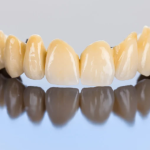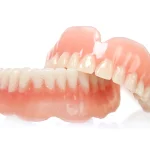Why Your Smile Is Worth More Than You Think
Let’s start with something simple but often overlooked: your smile isn’t just about teeth. It’s about presence.
In meetings, first impressions are made before you speak. In presentations, confidence communicates louder than your slides. In day-to-day exchanges—client calls, coffee breaks, elevator talk—your smile signals ease, competence, even trust.
Now imagine being hesitant to smile at all. Not for lack of warmth, but because you’re overly aware of what’s missing. A gap from a lost tooth. A denture that feels too obvious. When someone points a camera at you, you have the instinctive want to press your lips together.
Tooth loss is more common than you might imagine, frequently occurring after years of wear, gum disease, or accidents. However, it doesn’t get better if you ignore it. In fact, it makes things worse.
Missing teeth do more than just impact appearance. They begin a slow shift in how your mouth, and eventually, your face, functions. The jawbone starts to deteriorate. Neighboring teeth begin to drift. Your bite weakens, and speech gets clumsy. One lost tooth quietly sets off a chain reaction.
Which brings us to the solution many professionals are turning to—not as a luxury, but as a calculated, long-term decision: dental implants.
What Sets Implants Apart from Other Options


You’ve probably heard of bridges. Maybe you’ve seen a relative remove their dentures after dinner. These solutions are effective, but they require sacrifices. On the other hand, implants provide a fixed, stable, and almost undetectable effect by anchoring straight into the jawbone.
In technical terms, an implant is a tiny titanium post that is placed into the bone to function as a substitute root. Over time, your body accepts it—actually fuses to it—in a process called osseointegration. That’s the part that makes it more than just a replacement tooth. It becomes part of you.
Once healed, a custom-crafted crown is attached to the implant, matched in shape and shade to the rest of your teeth. It doesn’t shift. It doesn’t press on your gums. And it doesn’t come out at night.
This stability is more than just convenience for workers who balance unpredictable schedules and client-facing responsibilities; it’s consistency. Before an afternoon pitch, you don’t want to doubt your lunch choice or be concerned about your dentures falling out in front of a group of stakeholders.
Beyond the practical, though? Having a smile that feels complete again has a subtly significant effect.
Are You a Good Candidate for Implants?

That depends—but more than you’d expect, the answer is yes.
Implants are safe for the majority of healthy persons. A commitment to oral cleanliness and sufficient bone density—though bone grafts can assist if you’ve lost some—are important components. Implants are still an option for people with autoimmune diseases, diabetes, or smoking, but they just need to be planned more carefully.
Here’s a general snapshot of what qualifies someone for implants:
- Good gum health
- A strong jawbone or willingness to undergo grafting
- No untreated infections or long-term problems with dental health
- Willingness to adhere to post-operative treatment recommendations
- Non-smoker, or committed to quitting during healing
It’s important to schedule a consultation to determine your specific needs. The majority of dental implant providers assess bone quality, spacing, and surrounding structures using 3D imaging. Furthermore, even complicated situations can now be addressed precisely thanks to advancements in technology like surgical guides and CBCT scans.
This is not a blind jump. It’s a calculated, personalized plan.
What to Expect from the Process and the Timeline
Let’s be honest: this isn’t a “walk-in, walk-out” procedure. But it’s not as drawn-out as it sounds either.
The process usually unfolds in three stages:
- Consultation and Planning
Digital imaging, review of your health history, and any prep work like extractions or bone grafting happen here.
- Surgical Placement of the Implant
This is done under local anesthesia or light sedation. A small post is placed into the jaw, and healing begins.
- Healing and Crown Placement
Over the next 3–6 months, your bone fuses with the implant. Once secure, a permanent crown is attached, completing the restoration.
During the healing period, you may wear a temporary tooth or partial appliance. It’s functional and aesthetic, designed to hold you over discreetly until the final piece is ready.
While some providers advertise “teeth in a day,” those approaches are typically reserved for special cases and come with limitations. For most, the traditional route offers better results—especially long-term.
And that’s key: you’re not just fixing a moment. You’re building a future.
The Real ROI: What You Gain (and What You Avoid)
Cost is often the first question—and rightly so. Dental implants are an investment, with a single unit ranging from $3,000 to $5,000 depending on your location and the specifics of your treatment. Full-mouth or multiple implants increase that total, but so does complexity.
Now here’s what that number doesn’t show:
- Implants prevent jawbone loss (which no denture or bridge can claim)
- They require no adhesives, no nightly soaking, no dietary restrictions
- They last. With proper care, implants can go 20 years—or a lifetime
Contrast that with dentures, which need replacement every 5–7 years, or bridges, which can put extra strain on nearby healthy teeth. The “cheaper” solution can end up being more expensive over time—especially when factoring in the cumulative costs of adjustments, relines, and replacements.
It’s like buying one well-made suit versus three you constantly have to tailor.
And beyond cost? There’s the return of normalcy. You speak, chew, and smile with confidence. No fear of movement mid-sentence. No second-guessing your reflection in Zoom.
Choosing the Right Provider Matters
Not every dentist is trained in implant placement—and not every clinic has the technology to support a successful outcome. If you’re going to invest, choose wisely.
Ask your provider:
- How many implants have you placed?
- Do you use 3D imaging or guided surgery?
- What’s included in the quoted fee?
- What’s your success rate over 5 years?
- Who handles the surgical and restorative phases?
Avoid clinics that sell “same-day” solutions with zero context. It takes time to provide quality care, and this is particularly true for therapies that are intended to last decades. Consider your provider to be a business partner in your oral health, whose skill directly affects how well you function on a daily basis.
Final Thought: It’s Not Just About Teeth, It’s About You
You don’t need a perfect smile. You need a reliable one.
One that works when you’re negotiating a contract, hosting a webinar, or helping your child with homework after a 10-hour shift. One that keeps up with the life you’ve built and the standards you hold.
Dental implants aren’t just cosmetic. They’re structural. Emotional. Practical.
Therefore, if you’ve been putting it off, analyzing the costs, and questioning whether it’s worthwhile, think about this: How much would it cost in the long run to restore not only your bite but also your mobility, unhindered and unhidden?
That’s the smile investment. And for many, it’s one of the most solid choices they’ll ever make.
More News /Article






